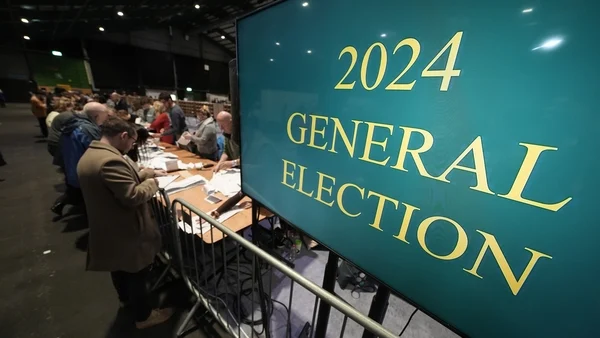First results are arriving from yesterday’s Irish parliamentary election. As always, this election involves the STV system in multi-member constituencies – a system that can help small parties by removing the ‘wasted vote’ argument that applies in countries like the UK.
But what this also means is that we have to wait a while for final results, as there are several rounds of counting, with voters’ second, third, fourth (etc) preferences being redistributed.
Many H&D readers worldwide will have been tricked by social media into believing that the anti-immigration ‘far right’ was about to make a political breakthrough in Ireland.
But there’s a big difference between brawling on the streets of Dublin – or building a profile as a social media star – and building a serious political movement.
These elections are set to confirm that much of the Irish ‘far right’ (typified by the absurd dispute between two rival leaders of the so-called ‘National Party’) is little more than a joke. Although the results also confirm that Irish voters have begun to reject both Sinn Féin and the ultra-woke agenda of parties like the Greens.
One of those ‘National Party’ factions formed a grandly titled ‘National Alliance’ in advance of these elections with two other tiny movements, ‘The Irish People’ and ‘Ireland First’ (the latter run by a former leftist turned conspiracy theorist). The three components of this ‘Alliance’ worked in an electoral pact, though retaining their own names on ballot papers: their results so far have been microscopically tiny, apart from in the Dublin West constituency, where Patrick Quinlan (who won a council seat earlier this year) polled a creditable 2.6% for the NP.
Early results indicate that the big beneficiaries of many Irish voters’ loss of faith in mainstream politics have been not the explicitly anti-immigration ‘far right’, but the socially conservative parties that emphasise Ireland’s traditional Catholic attitudes on issues such as abortion and homosexuality, and resist the ‘wokeism’ that Dublin’s political establishment seeks to impose.
Other anti-establishment votes have rallied behind localist independents without any visible link to the ‘right wing’.
Among early results, the leader of Ireland’s main social conservative party Aontú (which is backed by some old-fashioned republicans who years ago would have supported Sinn Féin / IRA) has finished a strong second to SF in his Meath West constituency. Peadar Tóibín, who will now expect to be joined in the Dáil (the Irish parliament) by perhaps up to five new Aontú colleagues, polled 20.1% of first preferences.
Significantly, Tóibín was only 2.8% behind Sinn Féin this time, whereas he was 12.9% behind in 2020. In 2011 and 2016 he was himself the successful SF candidate here. For obvious reasons, H&D are no friends of Tóibín and Aontú, but we must recognise their significant achievement in eating into the SF vote.

Predictably the other ‘right wing’ candidates were consigned to the fringe: Ben Gilroy, a former tenants’ rights activist turned Covid conspiracy theorist and leader of his own micro-party ‘Liberty Republic’, polled 1.1%, and ‘The Irish People’ candidate only 0.6%.
Similarly in the very different constituency of Dublin Fingal West (a suburb which has seen substantial immigration both of Eastern Europeans and non-Whites), Gilroy took just 1.4% and ‘The Irish People’ 0.4%, while a Farage-style party ‘Irish Freedom’ polled 1.3%. The main beneficiary of anti-establishment votes here was a local councillor standing as an independent, without any ‘right wing’ associations, who polled 11.9%.
Niall McConnell – a farmer active on social media, and best known to H&D readers as an ally of Ulster businessman Jim Dowson and his business partner Nick Griffin – polled 2.0% as an independent candidate in Donegal. This was well up from the 0.7% he polled in 2020.
McConnell (whose online interview guests have included NF veteran turned Catholic academic, Dr Joe Pearce) finished ahead of a rival anti-immigration candidate from ‘The Irish People’, who was backed by the ‘National Alliance’ electoral pact but polled only 0.7%, but behind the Aontú candidate who took 3.2%. There were many other fringe independents in Donegal whose second preferences McConnell might yet hope to have attracted.
In Limerick County, Aontú’s only significant rival as a socially conservative party – Independent Ireland – again polled very well, with the businessman and former Fianna Fáil councillor Richard O’Donoughue almost certain to return to the Dáil as one of at least three Independent Ireland TDs. He polled 23.2% of first preferences. Aontú managed 2.9% in this constituency, but the rest of the ‘far right’ had tiny votes: 0.6% each for ‘The Irish People’ and ‘Irish Freedom’.
Similar stories recurred in several other constituencies (especially rural areas) where anti-abortion social conservatives polled well. Carol Nolan (who defected from Sinn Féin in 2018 over the abortion issue) was easily re-elected again as an independent in Offaly, where this time she topped the poll with 22.2%. In Wexford, former Fine Gael candidate Verona Murphy – a businesswoman who was forced out of her old party five years ago in a row over her borderline ‘racist’ language about immigrants but won a seat in 2020 as an independent – was re-elected top of the poll with 21.6%, again as an independent.
However, in Dublin two of the best known socially conservative independent city councillors associated with the ‘respectable’ wing of the anti-immigration movement polled fairly well but failed to be elected to parliament. Gavin Pepper polled 5.6% in Dublin NW, and Malachy Steenson (a solicitor once associated with militant republicans) 4.9% in Dublin Central.
The good news so far for H&D readers is that Sinn Féin has lost its position as the largest of Ireland’s many parties, its vote has clearly slumped for the first time since 1989. SF leader Mary Lou McDonald was of course re-elected in Dublin Central but as we report elsewhere, faced the humiliation of a huge decline in her vote and the possible election of a bitter enemy, notorious gangster Gerry Hutch.
Irish working-class voters haven’t moved in large numbers to the ‘far right’, but they have begun to abandon Sinn Féin, and that can only be good news.


